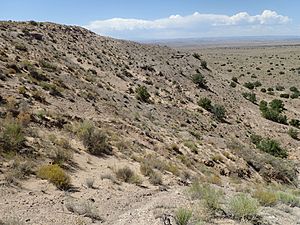Ceja Formation facts for kids
Quick facts for kids Ceja FormationStratigraphic range: Pliocene to Pleistocene, 7.1–1.25Ma |
|
|---|---|

Ceja Formation at its type section at El Rincon, west of Albuquerque, New Mexico
|
|
| Type | Formation |
| Unit of | Santa Fe Group |
| Sub-units | Rio Puerco Member, Atrisco Member, Santa Ana Mesa member |
| Underlies | Llano de Albuquerque geomorphic surface |
| Overlies | Arroyo Ojito Formation |
| Thickness | 94–104 meters (308–341 ft) |
| Lithology | |
| Primary | Sandstone |
| Other | Mudstone, conglomerate |
| Location | |
| Coordinates | 35°05′15″N 106°52′07″W / 35.0874°N 106.8686°W |
| Region | New Mexico |
| Country | United States |
| Type section | |
| Named for | Ceja Mesa |
| Named by | V.C. Kelley |
| Year defined | 1977 |
The Ceja Formation is a special type of rock layer found near Albuquerque, New Mexico. It formed a long, long time ago, during the Pliocene and Pleistocene periods.
Contents
What is the Ceja Formation Made Of?
This rock formation is mostly made of soft sandstone (like hardened sand) and conglomerate (rocks with pebbles and bigger stones glued together). Its colors can range from light yellowish-brown to reddish-yellow or pink.
Scientists believe these rocks were formed by ancient rivers. The lower layers are mostly sandstone mixed with mudstone (hardened mud). The upper layers have more sandstone and conglomerate, sometimes with small boulders.
The Ceja Formation sits on top of another rock layer called the Arroyo Ojito Formation. Its top layers are gravels that form the flat top of the Llano de Albuquerque area. Sometimes, you can find white pebbles in the lower layers. These are bits of older rock from the Arroyo Ojito Formation.
Where we can see it, the Ceja Formation is about 94–104 meters (308–341 ft) thick. However, deep underground, it can be much thicker, more than 420 meters (1,380 ft) in some places.
How Old is the Ceja Formation?
Scientists use fossils and special dating methods to figure out the age of the Ceja Formation. They have found that it formed during the Pliocene and Pleistocene periods.
For example, there's a layer of ash in the formation that matches ash from a volcanic eruption that happened 3.28 million years ago. Also, some lava flows found near or within the formation have been dated. One lava flow underneath the formation is about 3.00 million years old. Another lava flow inside the formation is about 2.68 million years old.
A fossil of a pocket gopher found in the formation also helps confirm its Pliocene age. Some lava flows near Las Lunas show that parts of the formation are as young as 1.25 million years old, extending its age into the Pleistocene.
Parts of the Ceja Formation
The Ceja Formation is divided into three main parts, called members:
- Atrisco Member: This part is reddish-brown mudstone and sandstone. It's about 85–100 meters (279–328 ft) thick and is mostly found underground.
- Rio Puerco Member: This member is named after the Rio Puerco river. It forms a very rough, gravelly top layer along the Ceja del Rio Puerco area.
- Santa Ana Mesa Member: This part is made of reddish-brown sandstone and conglomerate. It's easy to spot on the sides of Santa Ana Mesa. It even contains a layer of pumice (a type of volcanic rock) that is 7.1 million years old. This member is usually redder than the other parts of the Ceja Formation.
Images for kids


